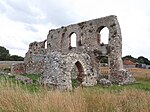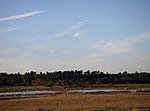Dunwich

Dunwich () is a village and civil parish in Suffolk, England. It is in the Suffolk Coast and Heaths AONB around 92 miles (148 km) north-east of London, 9 miles (14 km) south of Southwold and 7 miles (11 km) north of Leiston, on the North Sea coast. In the Anglo-Saxon period, Dunwich was the capital of the Kingdom of the East Angles, but the harbour and most of the town have since disappeared due to coastal erosion. At its height it was an international port similar in size to 14th-century London. Its decline began in 1286 when a storm surge hit the East Anglian coast, followed by two great storms in February and December of 1287, until it eventually shrank to the village it is today. Dunwich is possibly connected with the lost Anglo-Saxon placename Dommoc. The population of the civil parish at the 2001 census was 84, which increased to 183 according to the 2011 Census, though the area used by the Office of National Statistics for 2011 also includes part of the civil parish of Westleton. There is no parish council; instead there is a parish meeting.
Excerpt from the Wikipedia article Dunwich (License: CC BY-SA 3.0, Authors, Images).Dunwich
Beach Road East, East Suffolk
Geographical coordinates (GPS) Address Nearby Places Show on map
Geographical coordinates (GPS)
| Latitude | Longitude |
|---|---|
| N 52.2775 ° | E 1.6311111111111 ° |
Address
Beach Road East
Beach Road East
IP17 3DT East Suffolk
England, United Kingdom
Open on Google Maps









